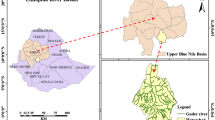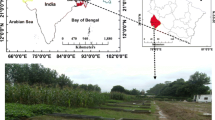Abstract
The Soil Conservation Service Curve Number runoff model is widely used in runoff prediction and has been incorporated into many software packages for watershed modeling. The Curve Number (CN) is the key parameter in the model, but it is largely dependent on Hydrologic Soil Group (HSG) classifications which may induce aggregation of detailed soil information. However, little attention and efforts have been paid to reduce such aggregation effect for retaining those valuable soil information to derive more detailed CN. This study proposed to integrate fuzzy logic to derive detailed CN. Membership of a given soil to each HSG is first calculated based on soil properties and HSG classification criteria; then, detailed and continuous CN is derived using the membership as weight for CN of each soil-cover complex. The proposed approach was incorporated into an automation system and its further effects on runoff modeling were examined. A case study shows fuzzy CN possesses more spatial details and leads to obvious spatial differences of simulated runoff. The developed system could also be used to detect inconsistency of HSG placements.










Similar content being viewed by others
References
Burrough PA (1989) Fuzzy mathematical methods for soil survey and land evaluation. Eur J Soil Sci 40:477–492
Elhakeem M, Papanicolaou A (2009) Estimation of the runoff curve number via direct rainfall simulator measurements in the state of Iowa, USA. Water Resour Manag 23(12):2455–2473
Hjelmfelt AT, Woodward DA, Conaway G, Quan QD, Mullem JV, Hawkins RH (2001) Curve Numbers, Recent Developments. In: Proceedings of the 29th IAHR Congress, Beijing, China. pp 285–291
Li RK, Zhu AX, Song XF, Li BL, Pei T, Qin CZ (2012) Effects of spatial aggregation of soil spatial information on watershed hydrological modelling. Hydrol Process 26(9):1390–1404
Mark DM, Csillag F (1989) The nature of boundaries on ‘area-class’ maps. Cartographica 26(1):65–78
McCuen RH (2004) Hydrologic analysis and design, 3rd edn. Prentice Hall, Upper Saddle River
Mishra S, Sahu R, Eldho T, Jain M (2006) An improved ia-s relation incorporating antecedent moisture in SCS-CN methodology. Water Resour Manag 20(5):643–660
Mishra S, Jain M, Suresh Babu P, Venugopal K, Kaliappan S (2008) Comparison of AMC-dependent CN-conversion formulae. Water Resour Manag 22(10):1409–1420
Musgrave GW (1955) How much of the rain enters the soil? US Department of Agriculture, Yearbook of Agriculture: Water. US Govt. Printing Office, Washington, DC, pp 151–159
Nielson RD, Hjelmfelt AT (1998) Hydrologic soil-group assignment. In: Abt SR, Young-Pezeshk J, Watson CC (eds) Water Resource Engineering 98. In: Proceedings of the International Water Resources Engineering Conference. American Society of Civil Engineers, Reston, Virginia, pp 1297–1302
Ponce VM, Hawkins RH (1996) Runoff curve number: has it reached maturity? J Hydrol Eng 1(1):11–19
Schaap MG, Leij FJ, van Genuchten MT (2001) ROSETTA: a computer program for estimating soil hydraulic parameters with hierarchical pedotransfer functions. J Hydrol 251(3–4):163–176
Shirmohammadi A, Yoon KS, Rawls WJ, Smith OH (1997) Evaluation of curve number procedures to predict runoff in GLEAMS. J Am Water Resour Assoc 33(5):1069–1076
Soil Conservation Service (1972) National Engineering Handbook. Section 4: Hydrology. Soil Conservation Service, Washington, DC
Soil Survey Division Staff (1993) Soil survey manual. Soil Conservation Service, Washington
USDA (2004) National Engineering Handbook, 210-VI. Part 630, chapter 9, Hydrologic Soil-Cover Complexes. Natural Resources Conservation Service, Washington, DC
USDA (2007) National Engineering Handbook, title 210-VI. Part 630, chapter 7, Hydrologic Soil Groups. Natural Resources Conservation Service, Washington, DC
Van Mullem JA (1991) Runoff and peak discharges using green-ampt infiltration model. J Hydrol Eng 117(3):354–370
Van Mullem JA, Woodward DE, Hawkins RH, Hjelmfelt AT Jr (2002) Runoff curve number method: beyond the handbook. Second Federal Interagency Hydrologic Modeling Conference, Las Vegas, Nevada
Ye XC, Zhang Q, Viney NR (2011) The effect of soil data resolution on hydrological processes modelling in a large humid watershed. Hydrol Process 25(1):130–140
Young DF, Carleton JN (2006) Implementation of a probabilistic curve number method in the PRZM runoff model. Environ Model Softw 21:1172–1179
Zhai H, Benson C (2006) The log-normal distribution for hydraulic conductivity of compacted clays: two or three parameters? Geotech Geol Eng 24(5):1149–1162
Zhu AX (1997) A similarity model for representing soil spatial information. Geoderma 77:217–242
Zhu AX, Band L, Vertessy R, Dutton B (1997) Derivation of soil properties using a soil land inference model (SoLIM). Soil Sci Soc Am J 61(2):523–533
Zhu AX, Hudson B, Burt JE, Lubich K, Simonson D (2001) Soil mapping using GIS, expert knowledge, and fuzzy logic. Soil Sci Soc Am J 65(5):1463–1472
Acknowledgments
The authors appreciated very much the anonymous reviewers for their valuable instructive comments in revising the manuscript. We thank Mingsi Xie from Research Laboratory for Conservation and Archaeology of Shanghai Museum who contributed discussions and help improve the language. This study is supported by the Key Research Program of Chinese Academy of Sciences (Grant No. KZZD-EW-13), National Water Pollution Control and Management Technology Major Project (2013ZX07103006-005), National Natural Science Foundation of China (Project No. 41201038 and 41023010), and is also supported by Chinese Academy of Sciences visiting professorship for senior international scientists (Grant No. 2012T1Z0039).
Author information
Authors and Affiliations
Corresponding author
Rights and permissions
About this article
Cite this article
Li, R., Rui, X., Zhu, AX. et al. Increasing detail of distributed runoff modeling using fuzzy logic in curve number . Environ Earth Sci 73, 3197–3205 (2015). https://doi.org/10.1007/s12665-014-3620-z
Received:
Accepted:
Published:
Issue Date:
DOI: https://doi.org/10.1007/s12665-014-3620-z




